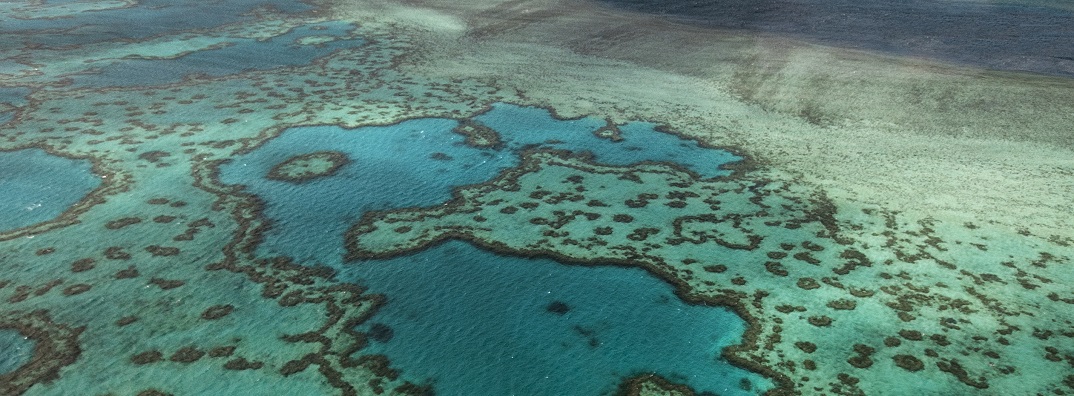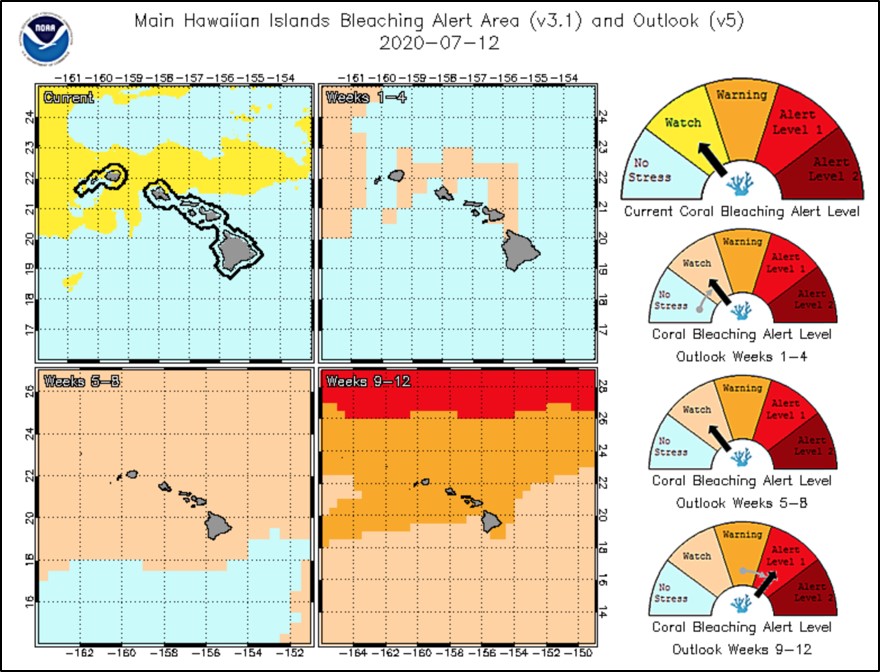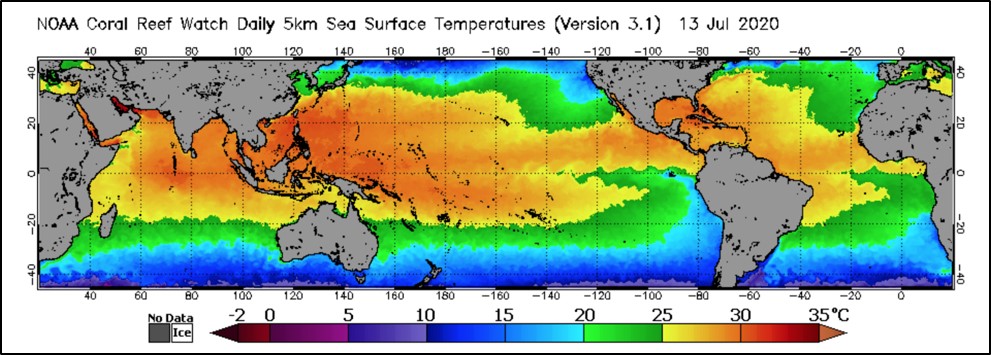- ABOUT US
- PROGRAM AREAS
- CONSERVATION APPROACH
- EDUCATION
- MULTIMEDIA
- Sea Surface Temperature,
- Sea Surface Temperature Anomaly,
- Coral Bleaching HotSpot (which measures the occurrence and magnitude of instantaneous heat stress that leads to coral bleaching),
- Degree Heating Week (a metric of accumulated heat stress in an area over the prior 12 weeks),
- Bleaching Alert Area (which shows areas where coral bleaching heat stress currently reaches various levels, based on Coral Reef Watch’s satellite SST monitoring), and
- 7-Day Sea Surface Temperature Trend.
A New Era of Monitoring the Coral Reef Environment from Space
By Leanne Poussard, Knauss Marine Policy Fellow

NOAA’s Coral Reef Watch has entered a new era in global coral reef environment monitoring with its next-generation daily global 5km-resolution satellite coral bleaching heat stress monitoring products. The high-resolution products replace Coral Reef Watch’s twice-weekly global 50km satellite coral bleaching heat stress monitoring products that informed coral reef ecosystem scientists, decision makers, resource managers, and the public around the world for more than 20 years. An archive of the heritage 50km data and products is available on the Coral Reef Watch website.

The daily global 5km satellite products include:
Coral Reef Watch also produces year-to-date (for the current year), monthly, and annual composites, as well as the most recent 30-day and 90-day animations of most of its daily global 5km satellite products. In addition, Coral Reef Watch offers Daily 5km Regional Virtual Stations/Bleaching Heat Stress Gauges (an example is shown above) and a free, automated 5km Satellite Bleaching Alert Email System, that are based on the global products.
The global network has monitored and predicted all major mass coral bleaching events observed since the original, heritage 50km satellite products were first introduced in 1997, demonstrating Coral Reef Watch’s success as a mainstay of global coral reef environment monitoring.
Mass coral bleaching is one of climate change’s most visible marine ecological impacts. Mass bleaching events have become more extensive, frequent, and intense over the last 40 years. Remotely monitoring the coral reef environment and providing actionable information are critical for early detection, on-the-ground response, impactful communication, and the enhancement of coral reef resilience. The new 5km products provide service at or near reef-scales and allow for the direct monitoring of 95 percent of coral reefs globally.

Coral Reef Watch’s products have been instrumental in enhancing understanding of the connections between environmental conditions and ecosystem impacts. The ability to assess when reefs are vulnerable or resilient to climate change allows stakeholders, including resource managers, scientists, and decision makers, to prepare and prioritize resources to implement timely and effective protective responses and adaptation actions to improve coral reef management and regulation in a warming climate.
Related Stories and Products
About Us

The NOAA Coral Reef Conservation Program was established in 2000 by the Coral Reef Conservation Act. Headquartered in Silver Spring, Maryland, the program is part of NOAA's Office for Coastal Management.

The Coral Reef Information System (CoRIS) is the program's information portal that provides access to NOAA coral reef data and products.
Work With US
U.S. Coral Reef Task Force
Funding Opportunities
Employment
Fellowship Program
Contracting Assistance
Graphic Identifier
Featured Stories Archive

Access the archive of featured stories here...
Feedback
Thank you for visiting NOAA’s Coral Reef Conservation Program online. Please take our website satisfaction survey. We welcome your ideas, comments, and feedback. Questions? Email coralreef@noaa.gov.
Stay Connected
Contact Us
NOAA’s Coral Reef Conservation Program
SSMC4, 10th Floor
1305 East West Highway
Silver Spring, MD 20910
coralreef@noaa.gov
